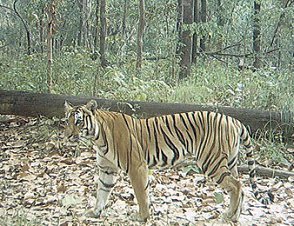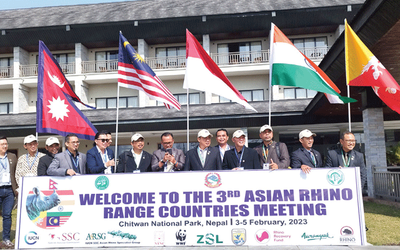
As China decides to lift a 25-year-old ban on trade in tiger bones and Rhino horns for "medicine and research purposes recently", there is growing concern that the decision will like to increase poaching significantly in Nepal and India.
With the strict measures, Nepal has made significant progress to protect the tigers and rhinos. Population of both endangered species has gone up drastically. However, the recent Chinese decision can reverse Nepal’s success in case a strict plans to protect Nepal’s wildlife.
With the various measurements, Nepal has been able to retain zero poaching of rhinos in the last three years and the population of tigers doubles in the last few years.
Experts argue that Beijing's decision will create an increase in demand for wildlife derivatives, risking animals in India and Nepal- home to world's largest wild tigers and single horned rhinos. The decision will also affect African countries, experts say.
Although China has set up about 6,000 tiger farms, products from there are not so much in demand as through poaching. "Tigers in the farms are much more expensive to obtain than those in wild. It is a proven fact that the consumers have demanded, and prefer wild tigers, for strength and power," Belinda Wright, wildlife conservationist and founder of Wildlife Protection Society of India (WPSI) told IANS.
According to WWF officials, China is currently working to establish rhino farms and is planning to procure them from Nepal and other countries. Nepal has already provided two rhino couples to China.
Wright says that the announcement by China had affected years of efforts by wildlife campaigners to curb demand for wildlife articles.
WWF has urged China to rethink its decision.
Tiger bones and other parts are used in traditional Chinese medicines, which have no clinically proven properties. Apart from Tigers and Rhinos, several other animals like Pangolin, leopard, clouded and snow leopards and bear are also preferred by Chinese black marketers. The bones and other derivatives of some Asian cats like leopards are used for around 36 different products in China, including bone wine.
At least 134 rhinos and 180 tigers were confirmed poached in India between 2013 and 2017. The figures were based on seizures. Foresters, though, believe that actually figures may be much higher.
"The Wildlife Justice Commission identified two parallel supply routes for illegal tiger trade, a trans-Himalayan route for wild and a Southeast Asian route for captive as well as wild, with the primary destinations China and, to a lesser extent, Viet Nam," an official document of the Convention on International Trade in Endangered Species of Wild Fauna and Flora (CITES) mentions.
According to a report by the Environmental Investigation Agency (EIA), over 5,030 leopards, 1912 tigers, 292 snow leopards and 95 clouded leopards were seized from illegal trade in Asia between 2002 and August 2018.
"The (Chinese) decision is a staggering display of brazen disregard for global opinion and seriously jeopardizes the future survival of wild tigers by stimulating demand for their body parts," Debbie Banks, Campaign Leader on Tigers and Wildlife Crime at EIA.
Saying that raising tigers in a farm requires a lot of clearances and big investments in infrastructure, Banks adds that most poaching gangs find it easier -- and cheaper -- to trap a tiger in the wild.
Banks, credited with exposing a secret order to use farmed tiger bone in 2013, said that the decision will put the animals from Africa and the Asian range countries at major risk. "It runs completely counter to everything that other tiger range countries such as India, Nepal, Bhutan and Russia are trying to do," she added.
Indian experts express serious concerns. Dipankar Ghosh, director Species and Landscape WWF-India, believes the Chinese decision will have direct consequences on Indian wildlife. "China doesn’t have population of wild tiger or the rhino. India is the nearest source. Trends show that whenever such trades are legalised, demand increases and black market booms," Ghosh.
According to experts, countries like South-Africa, that has stockpiles of rhino horns but cannot sell them due to agreements, will have leverage to send it to China, thereby increasing demands.
"Basiclly, the Chinese are conferring legal status to trade of captive tigers, not poaching. But Our problem is that you can't distinguish between the two in trade. This puts Indian wildlife at risk," Wright says.
China had banned trade of rhino horns and tiger bones in 1993, under the CITES Convention -- an agreement among more than 170 countries.
At a CITIES meeting held in Russia in September this year, demand was raised urging China to ban the leopard trade. The Chinese government said that it was currently considering it and will reply by the end of this year.
Defending its move on tiger and rhino, China said that the new norms sought to regulate derivatives from captivity for research and traditional medicines. The new norm, it claimed, would ensure "protection of the animals".
At a time when Nepal government itself is proposing more infrastructures projects near to protected areas and forest areas like Airport, Railways and roads, Chinese decision is another blow to Nepal’s wildlife. The recent decision to clear large areas of dense forest in Nijgadh, buffer zone of Parsa National Park close to Nepal India border, is sparking heated debate.
The report is based on IANS report.
- India Supported Construction Of Four Schools In Nuwakot
- Mar 19, 2021
- Nepal Denies Permission For Third Phase Trial Of Vaccine Against COVID-19
- Aug 31, 2020
- Messi Can Only Cancel Barcelona Contract If €700 Million Release Clause Is Paid, La Liga Confirms
- Aug 31, 2020
- India To Carry Out Study On Kathmandu-Raksaul Railway
- Aug 28, 2020
- COVID-19: 1,351 Personal Of Nepal Police Infected
- Aug 28, 2020
















